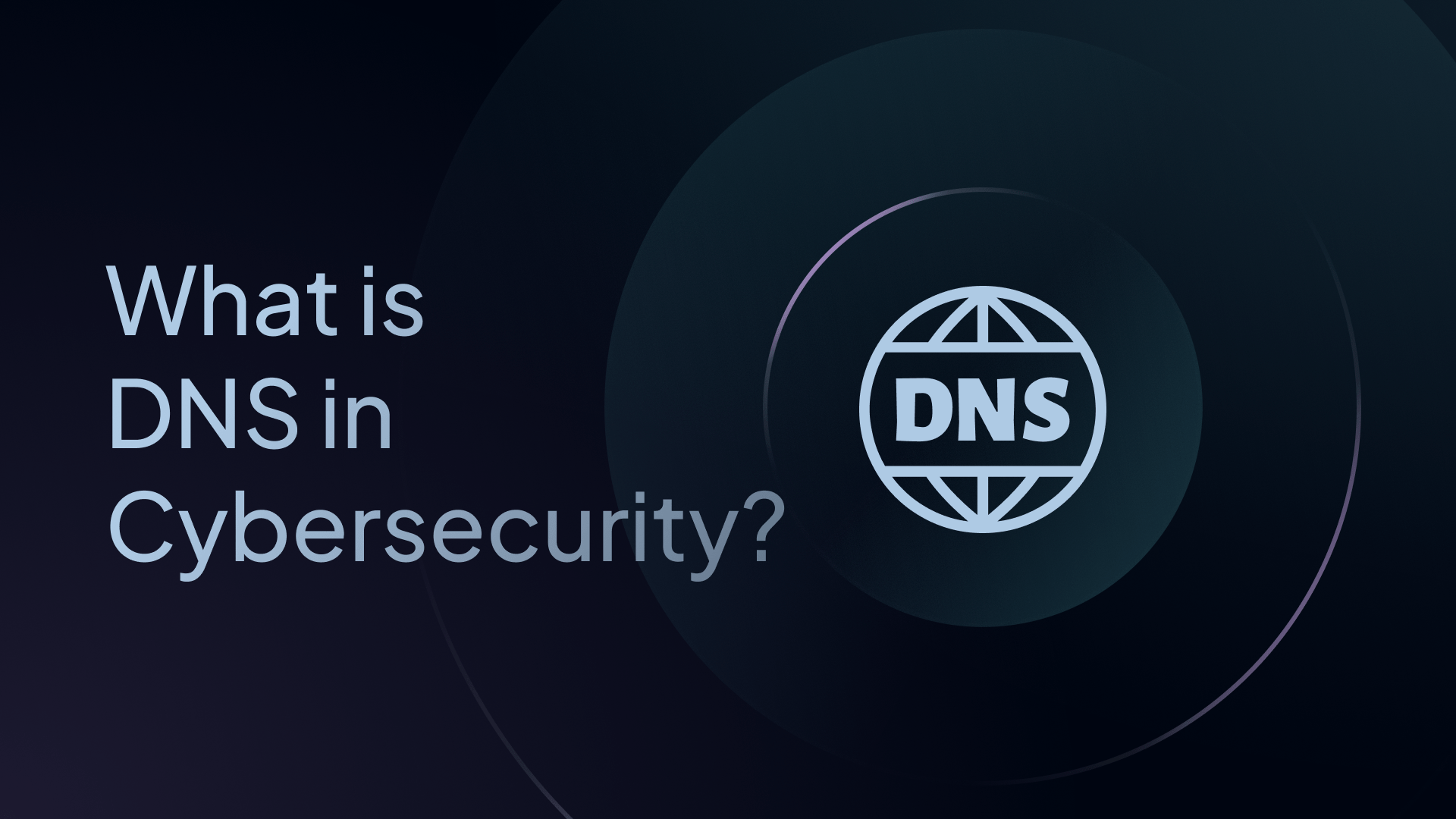What Is DNS in Cybersecurity? The Complete 2025 Guide to Risks, Attacks, and Defenses
This guide explains DNS in cybersecurity, common threats, and how Control D helps block malware, phishing, and data leaks at the DNS layer.

DNS makes the internet work, but it also opens the door to malware, phishing, and data exfiltration.
In this guide, we break down how DNS works, why it's a cybersecurity risk, and how filtering tools like Control D help defend this overlooked but vital layer of your network.
Summary
✅ DNS powers every internet request, but was never designed for security
✅ Hackers exploit it via spoofing, tunneling, typosquatting, and hijacking
✅ DNS filtering stops threats before they reach your users or devices
✅ Control D blocks malware, filters content, and logs DNS activity in real time
What Is DNS?
DNS stands for Domain Name System. When you type in a website name like example.com, DNS translates that name into an IP address, like 192.0.2.1, so your computer knows where to go. Without DNS, you’d have to remember long strings of numbers just to check your email or watch a video.
Here’s how DNS works:
- You type www.example.com into your browser.
- Your device sends a DNS query to a resolver.
- The resolver checks its cache or queries authoritative DNS servers.
- The correct IP address is returned.
- Your device connects to that IP address to load the website.
This process happens billions of times daily, silently powering everything from email to streaming to cloud infrastructure.
Why DNS Is Critical in Modern Cybersecurity
While DNS is essential to internet functionality, it was never built with security in mind. The original design focused on speed and redundancy, not authentication or encryption.
Today, that lack of built-in security makes DNS a prime target and tool for cybercriminals.
- It’s the first step in almost every internet connection.
- It’s often unmonitored or unencrypted, making it easy to exploit.
- It can be used to deliver, command, or conceal malware.
- DNS logs provide early warning signs of infection, compromise, or abuse.
In short, if you control or monitor DNS, you can prevent, detect, or disrupt many cyberattacks before they succeed.
6 Common DNS Attacks Used by Hackers
Cybercriminals love DNS because it’s everywhere and often ignored. Here are some of the most common DNS-based attacks:
1. DNS Spoofing / Cache Poisoning
- An attacker injects fake DNS records into a resolver's cache.
- Users are directed to malicious sites that look identical to the legitimate ones.
- Commonly used in phishing and malware delivery.
2. DNS Tunneling
- Hides malware traffic inside DNS requests to secretly exfiltrate data or receive commands.
- This bypasses traditional firewalls and can go undetected for months.
- Allows attackers to communicate with infected devices.
3. DNS Hijacking
- An attacker changes DNS settings on a router or device.
- Victims are redirected to fake login pages or phishing portals.
4. DNS Amplification Attacks
- Used in Distributed Denial of Service (DDoS) attacks.
- Small DNS queries with spoofed IPs are sent to vulnerable servers, which respond with large replies to the target, overwhelming it.
6. Typosquatting and Malvertising
- Attackers register domains that look like legitimate sites (amaz0n.com, gooogle.com).
- These are used to trick users into clicking and stealing sensitive data.
Core DNS Security Tools You Should Use
Here are the key tools and techniques that make DNS more secure:
1. DNSSEC (DNS Security Extensions)
DNSSEC adds digital signatures to DNS records so you can be sure the data hasn’t been tampered with.
Think of it like sealing a letter with wax. If the seal is broken, something’s wrong.
2. Encrypted DNS (DoH and DoT)
By default, DNS requests are sent in plain text. Anyone on the same network – even at a coffee shop – can spy on them.
That’s why encrypted DNS protocols like DNS over HTTPS (DoH) and DNS over TLS (DoT) are used to hide DNS traffic and protect user privacy.
3. Real-Time DNS Analytics
Logs and visualizes DNS activity in real time, helping you:
- Detect suspicious behavior
- Enforce policies
- Spot anomalies and potential threats
- Meet compliance standards
4. DNS Filtering
This is one of the most powerful tools in DNS security. It blocks access to dangerous sites based on categories (like malware, phishing, or adult content) or custom rules.
We’ll dive deeper into this next.
How DNS Filtering Blocks Cyber Threats
DNS filtering is the process of intercepting DNS queries and blocking or allowing them based on a set of policies or known threat intelligence.
How DNS filtering works:
- A user requests a domain (e.g., badsite.com).
- The DNS filtering service checks that domain against threat categories or allow/block lists.
- If the domain is flagged (malware, phishing, etc.), the request is blocked.
- If it’s clean, the DNS query proceeds normally.
This allows organizations to stop threats before the connection is ever established, meaning no malware gets downloaded, no fake websites get visited, and no sensitive data gets stolen.
Top 7 Benefits of DNS Filtering in Cybersecurity
✅ 1. Stops Malware and Phishing Early
Most cyberattacks start with a DNS request. Block it, and you break the chain before it starts.
✅ 2. Reduces the Risk of Data Exfiltration
Blocks domains commonly used for DNS tunneling and C2 communication.
✅ 3. Prevents Insider Misuse and Shadow IT
Blocks non-approved cloud apps, risky SaaS tools, and suspicious downloads, which open the door to threats. DNS filtering helps keep control.
✅ 4. Supports Zero Trust Architectures
Enforces least-privilege internet access by filtering DNS per user or device.
✅ 5. Protects BYOD and Remote Users
Employees working from home or on the go are harder to secure. DNS protection works everywhere, even outside your office network.
✅ 6. Enhances Compliance
Many privacy and security laws (like GDPR, HIPAA, and CCPA) require businesses to protect sensitive data. DNS security helps you meet those requirements.
✅ 7. Better Network Visibility
See where users are going online and spot unusual behavior fast.
Why Control D Is Built for DNS Security at Scale
Control D is more than just a DNS resolver – it’s a powerful security tool that helps protect your business from cyber threats at the DNS layer.
Whether you're a small company or a large enterprise, Control D gives you the visibility and control you need to keep your network safe.
Here’s how Control D helps your business stay safe and secure:
🦠 Stops Malware Before It Hits Your Network
- Top-Rated Malware Protection: In independent tests, Control D blocked 99.97% of malware domains – better than every other DNS service tested.
- Real-Time Threat Feeds: Uses constantly updated blocklists to stop known bad sites, phishing domains, and command-and-control servers before they load.
🧩 Multi-Tenancy for Easy Management
- Manage Multiple Clients or Groups: With Control D’s multi-tenancy, you can manage separate profiles, rules, and logs for different clients, departments, schools, or user groups – all under one account.
- Role-Based Access Control: Assign team members specific roles so they only see or manage what they need to.
- Perfect for MSPs and IT Teams: Simplifies large-scale deployments by keeping everything organized, secure, and easy to control from one dashboard.
🔄 Dynamic Profile Management
- Profiles for Different Needs: Make custom “Profiles” with different rules – like one for work hours and another for free time – and switch between them anytime.
- Schedule Profiles Automatically: Schedule Profiles to turn on/off at certain times or days without lifting a finger.
🌐 Block Specific Apps or Websites
- App & Service Filtering: Choose from over 1,000 blockable apps or services, like TikTok, YouTube, or Spotify.
- Category Filtering: Easily block groups of websites, like adult content, crypto, piracy, social media, or gambling.
📍 Geo-Custom Rules
- Location-Based Control: Implement rules based on the geographical location of source and destination IP addresses, allowing for region-specific policies.
🛠️ Advanced Custom Rules
- Total Control: You can block, redirect, or allow any domain name, even by using wildcards like *.example.com. All your rules are managed in a straightforward dashboard.
- Custom Block Pages: Show a branded or personalized message when someone hits a blocked site.
🌍 Choose Where Your Traffic Goes
- Traffic Redirection: Route your traffic through one of 100+ servers in over 60 countries.
📊 Smart Logging & Analytics
- Live DNS Logs: See which websites are being visited in real time, top blocked domains, or activity by user. Quickly spot and stop anything suspicious.
- Log Forwarding: Send DNS logs to your security tools (like SIEMs) for extra visibility and compliance.
🔒 Stay Safe with Modern DNS Protocols
- Encrypted DNS: Supports DoH, DoT, DoQ, and DoH/3 to keep your DNS traffic private and secure, even on public Wi-Fi or school networks.
💻 Cross-Platform Compatibility
- Cross-Device Protection: Use Control D on Windows, macOS, Linux, mobile phones, browsers, and routers. It works for individuals or whole networks.
💸 Transparent, All-Inclusive Pricing
- No Hidden Fees: Control D’s pricing is simple and predictable. You pay per Endpoint, with no surprise charges.
- Enterprise: $2 per endpoint/month
- MSPs: $1 per endpoint/month
- Schools & Non-Profits: Discounted pricing available
Every plan comes with full access to malware protection, analytics, custom rules, policy controls, and more, no costly add-ons required. Whether you're managing 10 users or 10,000, you get the same great features without jumping through pricing tiers.
Who Needs DNS Security
Honestly? Almost everyone.
Control D is ideal for:
- Businesses of all sizes
- Managed Service Providers (MSPs)
- Schools and libraries
- Remote or hybrid teams
- Healthcare and legal providers
- Homes and families
- Anyone who needs to protect user data
If your organization connects to the internet (and whose doesn’t?), DNS security is a must-have.
How to Get Started With DNS Security
Ready to boost your defenses? Here’s how to get started:
✅ Step 1: Sign up for a Control D account
Choose a plan that fits your business size and needs.
✅ Step 2: Set up your DNS
Follow the simple guides for Windows, Mac, iOS, Android, routers, or firewalls.
✅ Step 3: Create filter policies
Choose from preset categories or create custom rules for different teams and use cases.
✅ Step 4: Monitor and adjust
Review DNS activity, tweak filters, and stay ahead of threats.
Final Thoughts
DNS may be invisible to most users, but it plays a massive role in keeping your network safe.
By securing DNS, you block threats where they start – before they spread, before they do damage, and before they steal data – and take control of this hidden layer and turn it into your strongest shield.


